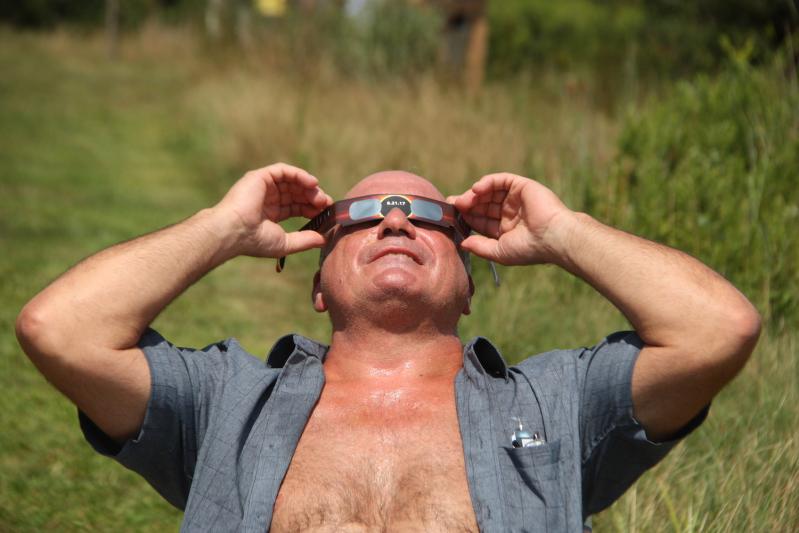New Yorkers are in for quite the celestial show on Monday afternoon: A total solar eclipse is coming our way, and the uppermost region of the state is squarely in the “path of totality,” or the area over which the sun will be fully obscured by the moon. Here on the South Fork, astronomers say people will be able to see between 83 and 90 percent totality.
It is the closest viewing of a total eclipse in East Hampton since Jan. 24, 1925 — several months shy of 99 years ago — when East Hampton itself was in the path of totality.
“A representative of the Scientific American was here yesterday looking for locations for a temporary observatory to be used in studying the eclipse of the sun Saturday morning,” The Star reported the week prior. “It is expected that about thirty scientists, with all kinds of equipment for registering the actions of the eclipse on radio, will come to East Hampton purposely to study this phenomenon.”
The writer of the article was Professor Caroline E. Furness of Vassar College, who went on to say that “instead of the brilliant orb of day in the heavens, we shall see a black circle surrounded by a pearly halo of light, called the corona.” She went on to correctly predict that the next solar eclipse visible in East Hampton would occur in 2024, and so here we are.
It’s quite literally, for many people, a once-in-a-lifetime opportunity to witness this sort of astronomical phenomenon. So rare, in fact, that you may not want to stick around here for it.
“If you really are interested in seeing a total eclipse, I would recommend traveling for it. It is such a rare opportunity to get a total eclipse so close to where we live,” said William Francis Taylor, a lifelong East End resident, mathematician, and astronomer who has been the Hamptons Observatory’s senior educator since 2019. “It will be a long, long time before we get a total eclipse on Long Island — about 50 years from now.”
Mr. Taylor is planning to travel to Texas, where the weather prediction is likely to be clear, to chase his second total solar eclipse. He was also in Texas for the 2017 eclipse. “It was a very emotional and beautiful experience,” he recalled. “It’s one of those things you think will be neat and then it’s totally overwhelming emotionally, aesthetically, and scientifically. It’s so out of the ordinary — there are aspects of the sun that you can’t see otherwise.”
Whereas Professor Furness called the corona a “pearly halo of light,” Mr. Taylor likened it to “beautiful, angelic wings coming from the sun.”
If science were a religion, a total solar eclipse would be akin to a high holy day. In 1919, a scientist named Arthur Stanley Eddington took advantage of such a celestial occurrence to prove Albert Einstein’s theory of relativity, which had been published just three years prior. Eddington “argued that the deflection, or bending, of light by the sun’s gravity could be measured,” wrote Peter Coles in the journal Nature in 2019. Eddington was correct.
Mary Griffin, an adjunct professor of astronomy at Suffolk Community College’s Riverhead campus, wants to you to know about a critical safety consideration during an eclipse: You can’t look directly at the sun. Don’t chance it — you could go blind, she said. Regular sunglasses won’t offer enough protection, nor will welder’s glasses. Get yourself a pair of ISO-12312-2 rated eclipse sunglasses.
“Take the warning seriously,” she said. “The worst thing you can do is look through anything with a lens, because a lens focuses the light. If you are looking through a camera with a viewfinder, you are not protected. That’s the thing you have to be serious about. As beautiful as it is, it is not worth your vision.”

Almost all local libraries are or will be handing out free pairs of eclipse glasses, as is Warby Parker, an eyeglass shop on Main Street in East Hampton. The Sag Harbor Variety store is selling four-packs of glasses for $9.99. They are also available at LongHouse Reserve, where an eclipse-viewing party is planned for Monday — with free admission if you register ahead of time at longhouse.org — from 1:30 to 4:30 p.m.
The South Fork Natural History Museum in Bridgehampton will co-host an eclipse viewing party with the Friends of Long Pond Greenbelt from 2 to 4 p.m. A $5 ticket includes a pair of glasses.
The East Hampton Library has games and activities planned during an eclipse party from 2 to 4 p.m. on Monday, when a limited number of pairs of glasses will be available as well.
There will also be a viewing party that afternoon at Camp Hero State Park in Montauk, featuring scientists and graduate students from Stony Brook University on hand to help people learn about and experience the eclipse. A website did not provide a time for the gathering. A similar event will take place at Hallock State Park Preserve on Sound Avenue in Riverhead, and other state parks farther west.
Schools have been preparing their students for this historic moment. For instance, Lisa McKee and Robin Lewis, who teach science at the John M. Marshall Elementary School in East Hampton, reported this week that children in kindergarten through second grade “have made models of the eclipse with paper and popsicle sticks to simulate how the moon will block the sun. They have also been using flashlights to carry out experiments with shadows.” Students in third through fifth grades have been learning “eclipse vocabulary” by “creating crafts that explore the phases of the eclipse. They have also been exploring the videos and interactive activities available on the National Geographic and NASA Science Space Place websites.” The school also bought eclipse glasses for students to use after school.
According to NASA, on Monday, the first region of the North American continent that will see the eclipse is the Pacific coast of Mexico at around 11:07 a.m. local time there. Texas will begin to see it shortly afterward. Then, NASA says, the eclipse will proceed above Oklahoma, Arkansas, Missouri, Illinois, Kentucky, Indiana, Ohio, Pennsylvania, New York, Vermont, New Hampshire, and Maine. The sweet spot for New York will be between 3:15 and 3:30 p.m. The darkness will last about four minutes or so.
Of course, it’s all weather dependent. A cloudy day will just seem dark over all. As of press time this week, the National Weather Service was predicting sunshine and mild temperatures.
Professor Griffin, too, is traveling to Texas for Monday’s eclipse, and has given her students the afternoon off from classes so that they can go out and experience the phenomenon for themselves.
There’s a mystique about it that “goes back almost to a primitive feeling in not just humans, but all animals,” she said. “It becomes totally dark. The birds start to settle in. There’s a real hush that goes on. The temperature changes; the weather can change. It’s a really magical moment.”
It serves to reinforce, she said, how the sun is “so life-sustaining for us. It’s just an awesome experience. Even if it’s only partial here for us on Long Island, it is really a spectacular thing to see.”




